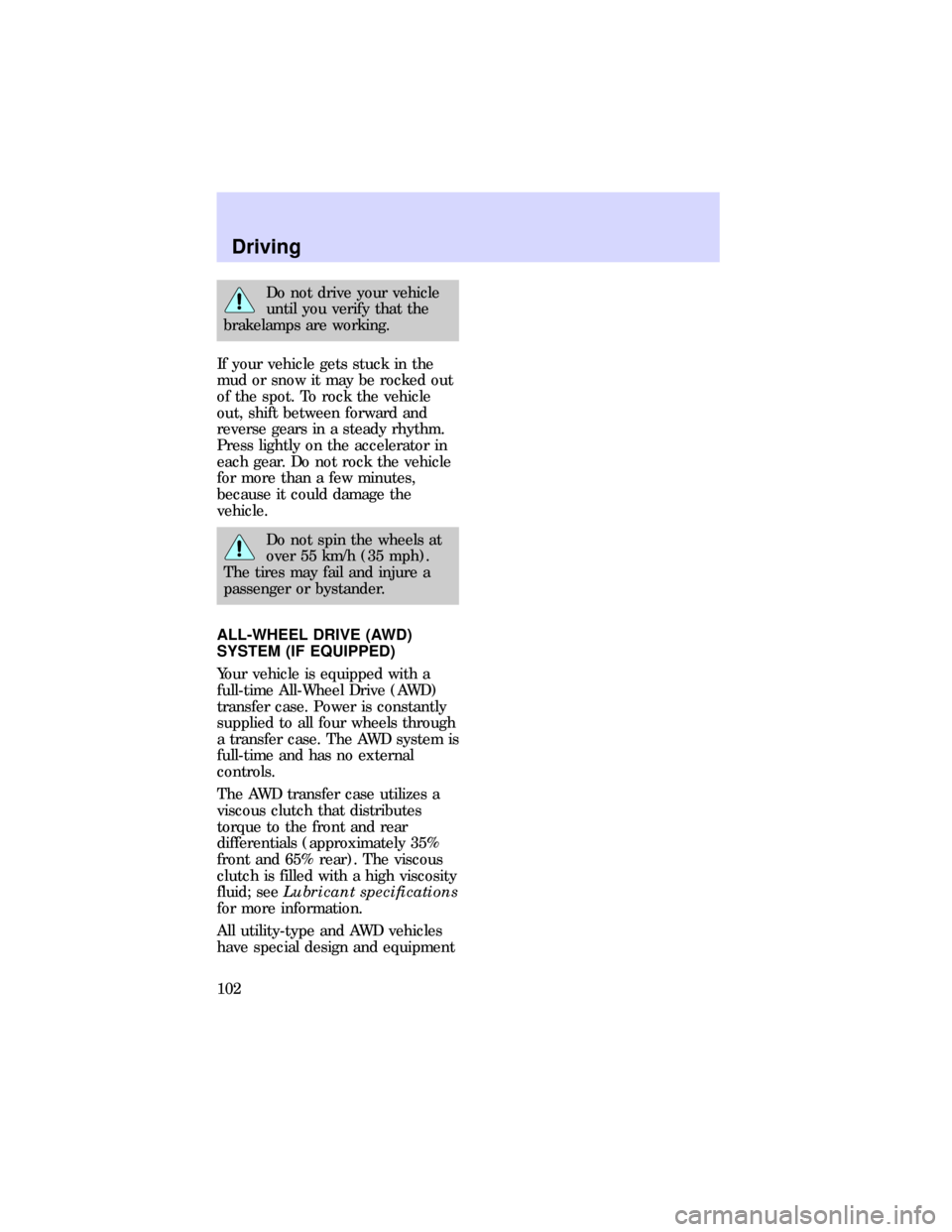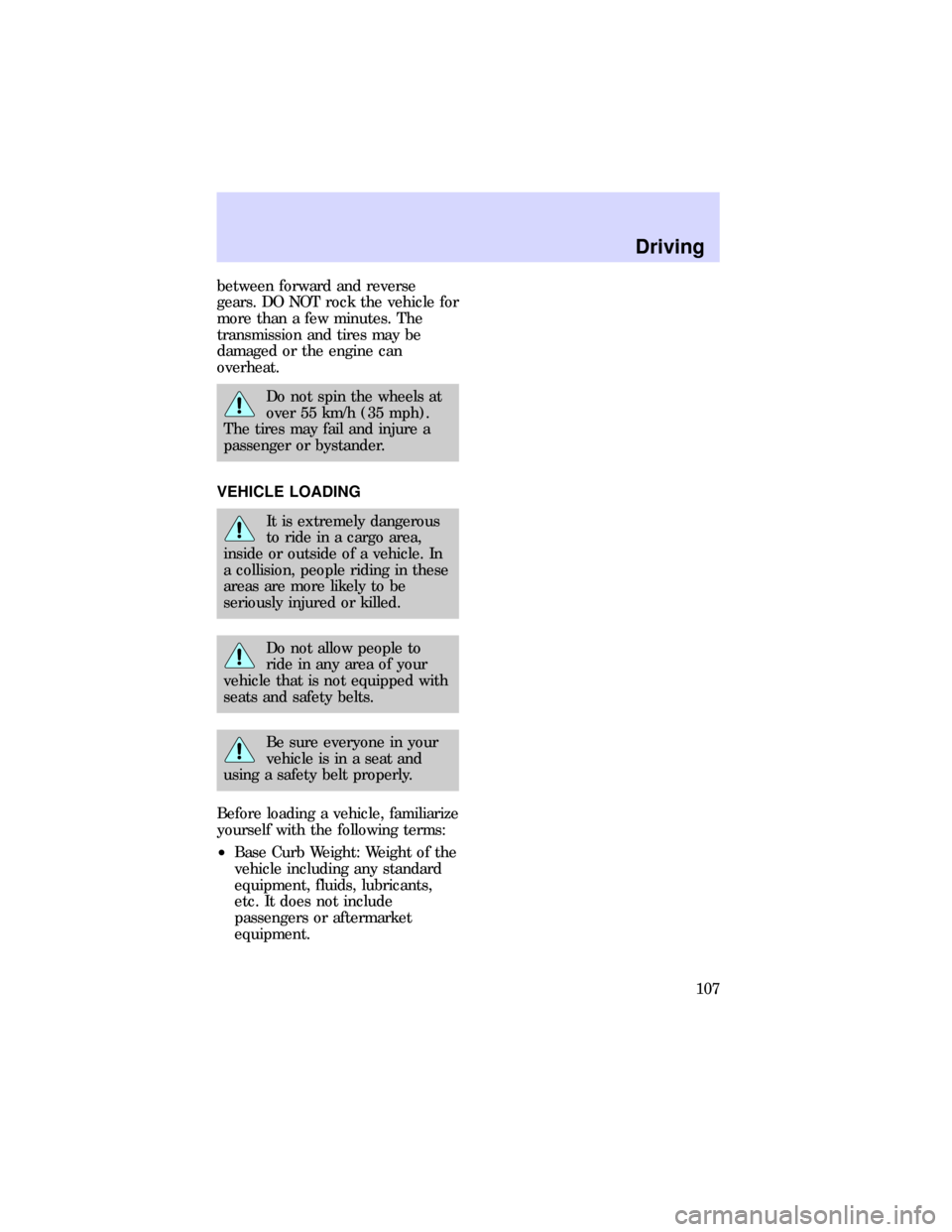Mercury Mountaineer 1997 Owner's Manuals
Manufacturer: MERCURY, Model Year: 1997, Model line: Mountaineer, Model: Mercury Mountaineer 1997Pages: 197, PDF Size: 2.08 MB
Page 101 of 197

on downgrades. Transmission
operates in gears 1-2.
1 - LowUse 1 (Low) to provide
maximum engine braking on steep
downgrades. Upshifts can be made
by shifting to 2 (Second) or to
D(Overdrive). Selecting 1 (Low)
at higher speeds causes a shift to 2
(Second), and will shift to 1 (Low)
after vehicle decelerates to the
proper speed.
Brake-shift interlock
This vehicle is equipped with a
brake-shift interlock feature that
prevents the gearshift from being
moved from P unless the brake
pedal is depressed.
If you cannot move the gearshift
out of P with the brake pedal
depressed:
1. Apply the parking brake.
2. Turn ignition key to LOCK, then
remove the key.
3. Insert the key and turn to OFF.
4. Apply brake pedal and shift to N
(Neutral).
5. Start the vehicle.
If it is necessary to use the above
procedure to move the gearshift, it
is possible that a fuse has blown
and the vehicle's brakelamps may
not be operating properly. Refer to
Fuses and relaysin theRoadside
emergencieschapter.
Driving
101
Page 102 of 197

Do not drive your vehicle
until you verify that the
brakelamps are working.
If your vehicle gets stuck in the
mud or snow it may be rocked out
of the spot. To rock the vehicle
out, shift between forward and
reverse gears in a steady rhythm.
Press lightly on the accelerator in
each gear. Do not rock the vehicle
for more than a few minutes,
because it could damage the
vehicle.
Do not spin the wheels at
over 55 km/h (35 mph).
The tires may fail and injure a
passenger or bystander.
ALL-WHEEL DRIVE (AWD)
SYSTEM (IF EQUIPPED)
Your vehicle is equipped with a
full-time All-Wheel Drive (AWD)
transfer case. Power is constantly
supplied to all four wheels through
a transfer case. The AWD system is
full-time and has no external
controls.
The AWD transfer case utilizes a
viscous clutch that distributes
torque to the front and rear
differentials (approximately 35%
front and 65% rear). The viscous
clutch is filled with a high viscosity
fluid; seeLubricant specifications
for more information.
All utility-type and AWD vehicles
have special design and equipment
Driving
102
Page 103 of 197

features to make them capable of
performing in a wide variety of
off-road applications. Specific
design characteristics give them
higher centers of gravity than
ordinary passenger cars.
Utility and four-wheel
drive vehicles are NOT
designed for cornering at speeds
as high as passenger cars any
more than low-slung sports cars
are designed to perform
satisfactorily under off-road
conditions. Avoid sharp turns or
abrupt maneuvers in these
vehicles.
DRIVING OFF ROAD WITH ALL-
WHEEL DRIVE (AWD)
Your vehicle is specially equipped
for driving on sand, snow, mud,
and rough terrain and has
operating characteristics that are
somewhat different from
conventional vehicles, both on and
off road. The following information
will help you learn to properly use
AWD.
When using AWD, maintain
steering wheel control at all times,
especially in rough terrain. Since
sudden changes in terrain can
result in abrupt steering wheel
motion, make sure you grip the
steering wheel from the outside.
Do not grip the spokes.
Drive cautiously to avoid vehicle
damage from concealed objects
such as rocks and stumps. You
Driving
103
Page 104 of 197

should either know the terrain or
examine maps of the area before
driving. Map out your route before
driving in the area. For more
information on driving off-road,
readFour-Wheelingin your
owner's portfolio.
Sand
When driving over sand, try to
keep all four wheels on the most
solid area of the trail. Do not
reduce the tire pressures but shift
to a lower gear and drive steadily
through the terrain. Apply the
accelerator slowly and avoid
spinning the wheels.
Mud and water
If you must drive through high
water, drive slowly. Traction or
brake capability may be limited.
When driving through water,
determine the depth; avoid water
higher than the bottom of the hubs
(if possible) and proceed slowly. If
the ignition system gets wet, the
vehicle may stall.
Once through water, always try the
brakes. Wet brakes do not stop the
vehicle as effectively as dry brakes.
Drying can be improved by moving
your vehicle slowly while applying
light pressure on the brake pedal.
After driving through mud, clean
off residue stuck to rotating
driveshafts and tires. Excess mud
stuck on tires and rotating
driveshafts causes an imbalance
Driving
104
Page 105 of 197

that could damage drive
components.
If the transmission and transfer
case are submerged in water, their
fluids should be checked and
changed, if necessary.
All rear axle lubricants must be
replaced every 160,000 km
(100,000 miles) or if the axle has
been submerged in water.
Otherwise, check the lubrication of
the rear axle according to the
intervals in theService Guide.
Driving on hill or slope terrain
When driving on a hill, avoid
driving crosswise or turning on
steep slopes. You could lose
traction and slip sideways. Drive
straight up, straight down or avoid
the hill completely. Know the
conditions on the other side of a
hill before driving over the crest.
When climbing a steep hill, start in
a lower gear rather than
downshifting to a lower gear from
a higher gear once the ascent has
started. This reduces strain on the
engine and the possibility of
stalling.
When descending a steep hill avoid
sudden braking. Rapid pumping of
the brake pedal will help slow the
vehicle and still maintain steering
control.
When speed control is on and you
are driving uphill, your vehicle
speed may drop considerably,
especially if you are carrying a
Driving
105
Page 106 of 197

heavy load. If vehicle speed drops
more than 15 - 25 km/h (8 - 14
mph) the speed control will cancel
automatically. Resume speed with
accelerator pedal.
If speed control cancels after
climbing the hill, reset speed by
pressing and holding the SET
ACCEL button or returning to
previous speed by pressing the
RESUME button (to resume
speeds over 50 km/h [30 mph]).
Automatic transmissions may shift
frequently while driving up on
steep grades. Eliminate frequent
shifting by shifting out of
D(Overdrive) into D (Drive).
Driving on snow and ice
An AWD vehicle has advantages
over two-wheel drive vehicles in
snow and ice but can skid like any
other vehicle.
Avoid sudden applications of
power and quick changes of
direction on snow and ice. Apply
the accelerator slowly and steadily
when starting from a full stop.
When braking, apply the brakes as
you normally would. In order to
allow the anti-lock brake system
(ABS) to operate properly, keep
steady pressure on the brake
pedal.
Allow more stopping distance and
drive slower than usual. Consider
using one of the lower gears.
If the vehicle is stuck, shift the
transmission in a steady motion
Driving
106
Page 107 of 197

between forward and reverse
gears. DO NOT rock the vehicle for
more than a few minutes. The
transmission and tires may be
damaged or the engine can
overheat.
Do not spin the wheels at
over 55 km/h (35 mph).
The tires may fail and injure a
passenger or bystander.
VEHICLE LOADING
It is extremely dangerous
to ride in a cargo area,
inside or outside of a vehicle. In
a collision, people riding in these
areas are more likely to be
seriously injured or killed.
Do not allow people to
ride in any area of your
vehicle that is not equipped with
seats and safety belts.
Be sure everyone in your
vehicle is in a seat and
using a safety belt properly.
Before loading a vehicle, familiarize
yourself with the following terms:
²Base Curb Weight: Weight of the
vehicle including any standard
equipment, fluids, lubricants,
etc. It does not include
passengers or aftermarket
equipment.
Driving
107
Page 108 of 197

²Payload: Combined maximum
allowable weight of cargo,
passengers and optional
equipment. The payload equals
gross vehicle weight rating
(GVWR) minus base curb
weight.
²GVW (Gross Vehicle Weight):
Base curb weight plus the
payload weight (including
passengers, cargo, and optional
equipment). Remember, the
GVW is not a limit or a
specification.
²GVWR (Gross Vehicle Weight
Rating): Maximum total weight
of the base vehicle, passengers,
optional equipment and cargo.
The GVWR is specific to each
particular vehicle and is listed
on the Safety Compliance
Certification Label on the
driver's door pillar.
²GAWR (Gross Axle Weight
Rating): Carrying capacity for
each axle system (front and
rear). This amount is specific to
each particular vehicle and is
listed on the Safety Compliance
Certification Label on the
driver's door pillar.
²GCWR (Gross Combined Weight
Rating): Maximum combined
weight of the towing vehicle
(including passengers and
cargo) and the trailer. The
GCWR indicates the maximum
loaded weight that the vehicle is
allowed to tow.
Driving
108
Page 109 of 197

²Maximum Trailer Weight Rating:
Maximum weight of a trailer the
vehicle is permitted to tow. The
maximum trailer weight rating
equals the vehicle curb weight
for each engine/transmission
combination, any required
option weight for trailer towing
and the weight of the driver
from the GCWR for the towing
vehicle.
²Maximum Trailer Weight:
Maximum weight of a trailer the
loaded vehicle (including
passengers and cargo) is
permitted to tow. It is
determined by subtracting the
weight of the loaded towing
vehicle from the GCWR for the
towing vehicle.
²Trailer Weight Range: Specified
weight range that the trailer
must fall within that ranges from
zero to the maximum trailer
weight rating.
Remember to figure in the tongue
load of your loaded trailer when
figuring the total weight.
If the GVWR or the GAWR
specified on the Safety
Compliance Certification Label is
exceeded, your vehicle may be
damaged or you may lose control
and injure someone.
To obtain correct weights, try
taking your vehicle to a shipping
company or an inspection station
for trucks.
Driving
109
Page 110 of 197

Do not use replacement tires with
lower weight capacities than the
original because they may lower
the vehicle's GVWR and GAWR
limitations. Replacement tires with
a higher weight limit than the
originals do not increase the
GVWR and GAWR limitations.
TRAILER TOWING
Your vehicle may tow a Class I or
II trailer provided the maximum
trailer weight is less than or equal
to the maximum trailer weight
listed for your engine and rear axle
ratio. See theTrailer towing table
later in this chapter.
Do not exceed the maximum loads
stated on the Safety Compliance
Certification Label. Refer to
Vehicle loadingfor a definition of
the terms on the label.
Your vehicle's load capacity is
designated by weight, not by
volume, so you cannot necessarily
use all available space when
loading a vehicle.
Distribute the trailer load so that
only 10 to 15% of the total weight
of the trailer is on the tongue. Tie
down the load so that it does not
shift and change the weight on the
hitch.
Towing a trailer places an
additional load on your vehicle's
engine, transmission, axle, brakes,
tires and suspension. Inspect these
components carefully before and
after any towing operation.
Driving
110